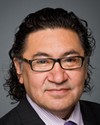Thank you very much, and welcome to Treaty 1 territory. I would have preferred the forum to be held on the Brokenhead Ojibway Nation or even Sandy Bay First Nation. However, I was one of the signatories to the Treaty Land Entitlement Framework Agreement in 1997, and I was also first chair of treaty land entitlement in 1977. I wear this ring very proudly, but I'd feel a lot better if we reached conclusion one of these days soon.
Our nationhood, of course, consists of sovereignty and self-determination through our land and borders, our citizens, our language, our cultural identity, our governing bodies, our laws, our judicial system, and an economic base. The loss of our land is the main focus through the claims process, but it doesn't consider the loss of our governance, the loss of our law, our ability, our language, our identity, our culture, our spirituality, and our economic base of hunting, fishing, trapping, and gathering. The model should have been the Selkirk Treaty of 1817. It conforms to the spirit of the Royal Proclamation of 1763, which provided the constitutional framework for indigenous land entitlement and has been referred to as Canada's Indian Magna Carta.
The crown needs to honour the visionary leadership and friendship such as that of Chief Peguis and Lord Selkirk that led to the signing of the 1817 treaty. The settler communities have failed to honour the full spirit and intent of the subsequent treaties. In agreeing to its terms, Chief Peguis and Lord Selkirk promoted peace, order, and a spirit of mutual assistance and co-operation, which is at the foundation of Manitoba's unique history. At the signing, Chief Peguis allotted a certain area for the settlers; the rest was ours, and our laws were to continue to prevail.
However, in August 1871, our nation became signatory to Treaty No.1. With this signing, the promise was made that the consensus would be carried out and the land would be allocated to our nation on a per capita basis, 160 acres per family of five. Our nation is located only 40 minutes from Fort Garry, where our ancestors signed Treaty No.1. With the initial land allocation, our nation was allocated 13,184 acres, and a shortfall of more than double the land base our nation had been entitled to be allocated was created.
Today, only 30% can be readily developed, and the remainder is marsh area. Our nation, along with half of the Indian bands in Manitoba, became signatory to the 1997 Treaty Land Entitlement Framework Agreement in September 1998. Through this framework agreement, Brokenhead became entitled to receive an additional 14,481 acres to address the shortfall from 127 years prior. We have yet to obtain and convert over 13,000 acres to reserve status, and in between addressing our land allocation shortfall, other parts of our land were taken for the purposes of the railway, provincial Highway 59, and a hydro transmission line, all of which we are still working to resolve. Brokenhead is currently addressing the claim through the specific claims process for the railway, railway station grounds, and hydro transmission line, which currently involve 111.7 acres of our land. Other areas of our land have either been or still are occupied by the churches and the Hudson's Bay Company.
We also live in an era in which we are forced to create satellite reserves and jump through the endless reserve-creation hoops that continue to delay our use and the benefit of our land.
Our nation works hard to address the legacy and resolution of our treaty, per capita shortfalls, land selection, acquisition, third party interests, municipal relations, reserve creation through the additions-to-reserve policy, and the loss of use and opportunities of our land. We settled a claim through the pre-tribunal specific claims process in 1985. We settled for 210 acres, and this settlement did not represent the loss of use and opportunities, nor of any other additional losses. Quantifying the impact of losses is a lengthy and costly exercise that doesn't consider all the other losses I previously identified.
When we had our oral history evidentiary hearing in our nation, the hearing environment was very adversarial. One elder who provided oral historic knowledge was challenged by a mainstream technical and time-scientific position by the crown. One elder stated afterwards in private that, “The crown really worked hard to make a fool out of me.” I was so embarrassed for having put him in that position. I even almost felt like saying, “I am guilty.”
The funding process does not realistically consider the efforts required by a first nation to participate in the specific claims process fairly. Expensive time is spent by our community staff and leadership to come together to determine what, if any, evidence can be uncovered within our nation. When our nation is involved in this kind of land claims process, we require additional time and resources in order to reassure our nation's citizens that we're not losing or giving up any more land due to crown-first nation legacy issues.
The current process requires our first nation to submit a budget proposal to Canada that narrowly states the total actual costs of the process, which does not consider supporting the community-involved process undertaken to attempt to provide our historical evidence.
Legal processes and legal representation are prioritized rather than the potential contributions of our nation. As well, there are staff changes with Canada. Then our file is further delayed because of lack of communication. There doesn't appear to be any succession planning so that our file will continue to proceed.
It's very concerning that a majority of claims are not yet settled through the tribunal. As the delay proceeds, there are many missed opportunities, and loss of use, potential growth, and betterment of the nation are impaired.
BON increasingly continues to experience a negative impact of the historical taking of our lands for purposes such as railway transportation and hydroelectricity. BON is working very hard to catch up to the progress that has been made by our treaty counterparts during the past 146 years. As you have heard, we have been attempting to do this, basically with the same land base we were originally allocated in 1871.




